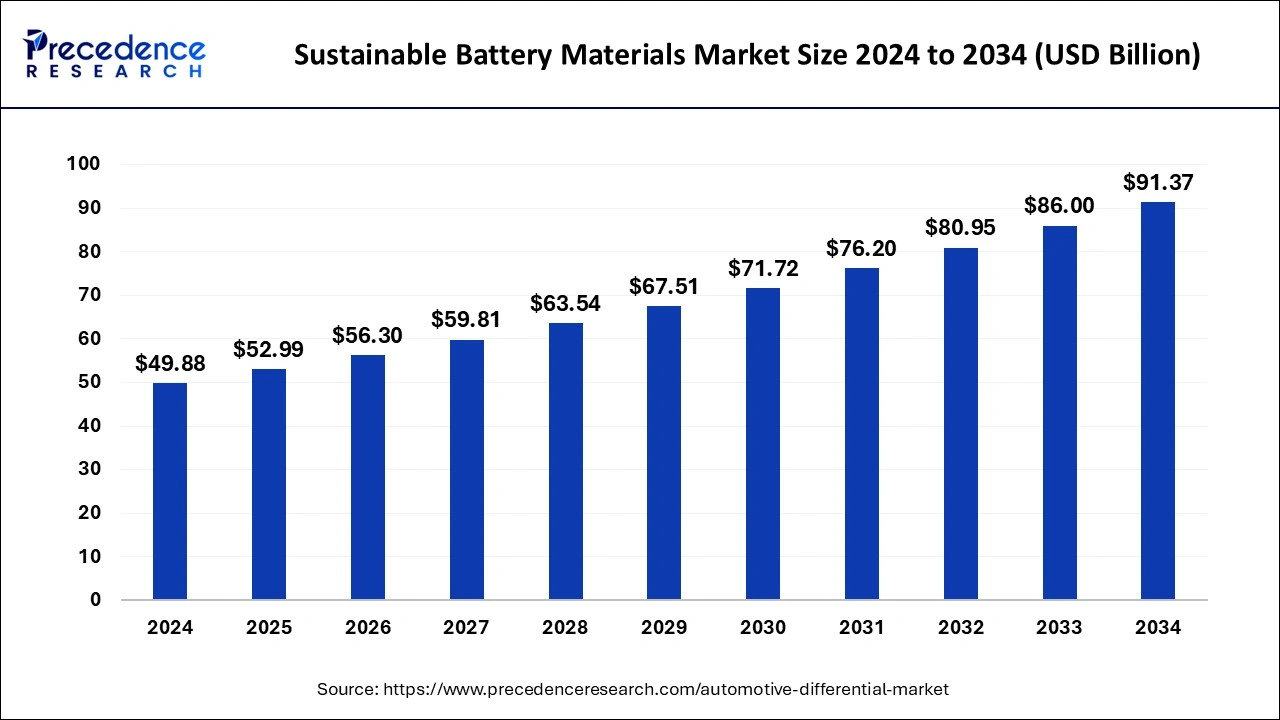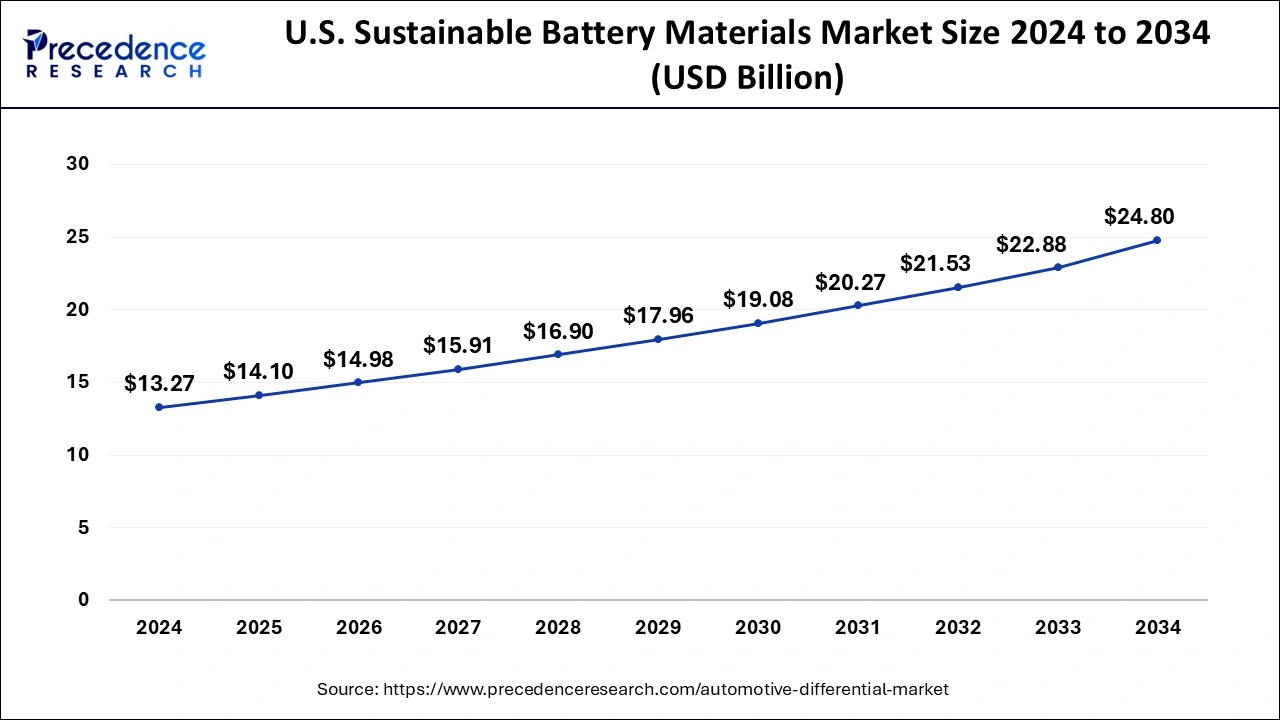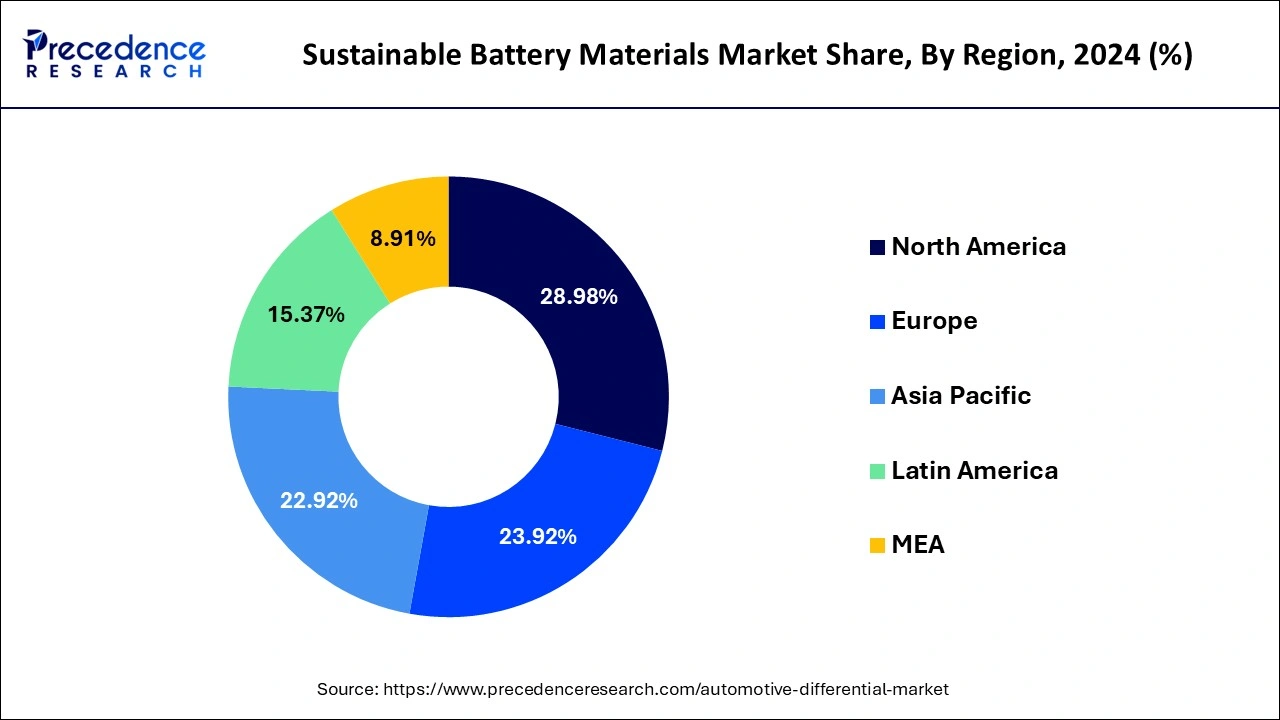January 2025
The global sustainable battery materials market size is accounted at USD 52.99 billion in 2025 and is forecasted to hit around USD 91.37 billion by 2034, representing a CAGR of 6.24% from 2025 to 2034. The North America sustainable battery materials market size was estimated at USD 18.95 billion in 2024 and is expanding at a CAGR of 6.45% during the forecast period. The market sizing and forecasts are revenue-based (USD Million/Billion), with 2024 as the base year.
The global sustainable battery materials market size was accounted for USD 49.88 billion in 2024 and is anticipated to reach around USD 91.37 billion by 2034, growing at a CAGR of 6.24% from 2025 to 2034. The rising demand for clean battery materials, surging investments in developing sustainable battery materials and the increased global impact of conventional energy sources on health and environment are driving the growth of the sustainable battery materials market.

AI integration in development of sustainable battery materials has sped up the process of identifying potential novel materials, in extending the battery life, for discovering new electrolytes, in better grid integration of energy sources and also in accelerating the research process thereby contributing in improved sustainability with reduced manufacturing costs and energy wastage.
For instance, in January 2024, Microsoft in collaboration with the U.S. Department of Energy’s (DOE) Pacific Northwest National Laboratory (PNNL) announced the discovery of a solid-state electrolyte named N2116 which could reduce the use of lithium by up to 70%. The discovery was made using Microsoft’s Azure Quantum Elements which combined AI and traditional high-performance computing (HPC) for analyzing over 32 million potential inorganic materials in less than nine months.
The U.S. sustainable battery materials market size was evaluated at USD 13.27 billion in 2024 and is predicted to be worth around USD 24.80 billion by 2034, rising at a CAGR of 6.45% from 2025 to 2034.

Asia-Pacific dominated the sustainable battery materials market in 2024. The regional growth is predicted to be aided by rapid urbanization and rising consumer spending on electric vehicles.

North America is expected to develop at the fastest rate during the forecast period. This is due to the fast adoption of electric vehicles in this region as well as increased consumer electronics purchases. The government is supporting investors in the renewable and electric vehicle industries, which is driving demand for battery-based energy storage systems, particularly lithium-ion batteries, which will help the region to flourish.
| Report Coverage | Details |
| Market Size in 2025 | USD 52.99 Billion |
| Market Size by 2034 | USD 91.37 Billion |
| Market Growth Rate from 2025 to 2034 | CAGR of 6.24% |
| Largest Market | Asia Pacific |
| Base Year | 2024 |
| Forecast Period | 2025 to 2034 |
| Segments Covered | Battery Type, Material, Application, Geography |
| Regions Covered | North America, Europe, Asia-Pacific, Latin America and Middle East & Africa |
Surging Investments in Recycling and Development of Sustainable Battery Materials
The initiatives taken by various industries for recycling and development of sustainable battery materials with increasing investments and fundings is driving the market growth. Furthermore, the advancements in manufacturing capabilities with streamlined workflows and supply distributions is aiding industries in reduced production costs and minimizing energy wastage.
Higher Investment and Development Costs
The requirement of huge investments for initiation, development, sourcing and supply chain distributions for sustainable battery materials can be major restraint hindering the growth as these production facilities need to meet the stringent carbon footprint and emission satndards.
Rising Government Support Towards Climate-Neutral Technologies
The increased awareness and government support for promoting various initiatives and stringent regulations for development for sustainable energy sources for reducing environmental impact and increasing resource efficiency.
The lithium-ion segment dominated the sustainable battery materials market share in 2024. Due to its color memory effect, high energy density, and low self discharge, it is employed in portable electronic devices. It’s used in a variety of industries including consumer electronics, industrial, and automotive.
The lead acid segment, on the other hand, is predicted to develop at the quickest rate in the future years. The global demand for lead acid batteries is increasing as a result of its qualities such as ease of purchase, reliability, abuse tolerance, overcharging tolerance, and the capacity to deliver high currents.
The cathode segment dominated the sustainable battery materials market share in 2024. The cobalt, nickel, and manganese are the most active elements in cathode materials. Nickel, primarily lithium nickel manganese oxide and nickel cobalt aluminum oxide, is now used to partially replace cobalt.
The anode segment, on the other hand, is predicted to develop at the quickest rate in the future years. The conventional current enters a polarized electrical device through an anode, which is an electrode.
The consumer electronics segment dominated the sustainable battery materials market share in 2024. The growing use of lithium-ion batteries in consumer gadgets is expected to boost total sustainable battery materials industry growth.
The automotive segment, on the other hand, is predicted to develop at the quickest rate in the future years. The sustainable battery materials market is being driven by a boom in global automotive sales and production, which has resulted in a rise in vehicle electrification.
By Battery Type
By Material
By Application
By Geography
For inquiries regarding discounts, bulk purchases, or customization requests, please contact us at sales@precedenceresearch.com
No cookie-cutter, only authentic analysis – take the 1st step to become a Precedence Research client
January 2025
February 2025
September 2024
January 2025